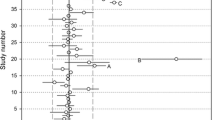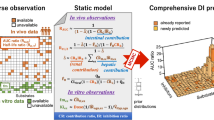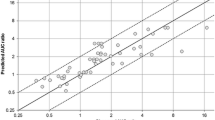Abstract
Metabolic drug interactions are a major source of clinical problems, but their investigation during drug development is often incomplete and poorly specific. In vitro studies give very accurate data on the interactions of drugs with selective cytochrome P450 (CYP) isozymes, but their interpretation in the clinical context is difficult. On the other hand, the design of in vivo studies is sometimes poor (choice of prototype substrate, doses, schedule of administration, number of volunteers), with the risk of minimising the real potential for interaction.
To link in vitro and in vivo studies, several authors have suggested using extrapolation techniques, based on the comparison of in vitro inhibition data with the active in vivo concentrations of the inhibitor. However, the lack of knowledge of one or several important parameters (role of metabolites, intrahepatocyte accumulation) often limits the possibility for safe and accurate predictions. In consequence, these methods are useful to complement in vitro studies and help design clinically relevant in vivo studies, but they will not totally replace in vivo investigation in the future.
We have developed a computerised application, the quantitative drug interactions prediction system (Q-DIPS), to make both qualitative deductions and quantitative predictions on the basis of a database containing updated information on CYP substrates, inhibitors and inducers, as well as pharmacokinetic parameters. We also propose a global approach to drug interactions problems — ‘good interactions practice’ — to help design rational drug interaction investigations, sequentially associating in vitro studies, in vitro/in vivo extrapolation and finally well-designed in vivo clinical studies.






Similar content being viewed by others
References
Krayenbühl JC, Vozeh S, Kondo-Oestreicher M, et al. Drugdrug interactions of new active substances: mibefradil example. Eur J Clin Pharmacol 1999; 55: 559–65
Nelson DR, Koymans L, Kamataki T, et al. P450 superfamily: update on new sequence, gene mapping, accession number and nomenclature. Pharmacogenetics 1996; 6: 1–42
Smith G, Stubbins MJ, Harries LW, et al. Molecular genetics of the human cytochrome P450 monooxygenase superfamily. Xenobiotica 1998; 28: 1129–65
Guengerich FP. Human cytochrome P450 enzymes. In: Ortiz de Montellano PR, editor. Cytochrome P450, structure, mechanism and biochemistry. New York: Plenum Press, 1995: 473–535
Wrighton SA, Stevens JC. The human hepatic cytochromes P450 involved in drug metabolism. Crit Rev Toxicol 1992; 22: 1–21
Pelkonen O, Mäenpää J, Taavitsainen P, et al. Inhibition and induction of human cytochrome P450 (CYP) enzymes. Xenobiotica 1998; 28: 1203–53
Michalets EL. Update: clinically significant cytochrome P-450 drug interactions. Pharmacotherapy 1998; 18: 84–112
Guengerich FP. Roleofcytochrome P450 enzymesindrug-drug interactions. Adv Pharmacol 1997; 43: 7–35
Physican’s Desk Reference. Montvale (NJ): Medical Economic Co., 1996
Spyker DA, Harvey ED, Harvey BE, et al. Assessment and reporting of clinical pharmacology information in drug labelling. Clin Pharmacol Ther 2000; 67: 196–200
Huang SM, Lesko LJ, Williams RL. Assessment of the quality and quantity of drug-drug interaction studies in recent NDA submissions: study design and data analysis issues. J Clin Pharmacol 1999; 39; 1006–14
Gillam EM. Human cytochrome P450 enzymes expressed in bacteria: reagents to probe molecular interactions in toxicology. Clin Exp Pharmacol Physiol 1998; 25: 877–86
Gonzalez FJ, Korzekwa KR. Cytochrome P450 expression systems. Annu Rev Pharmacol Toxicol 1995; 35: 369–90
Renaud JP, Peyronneau MA, Urban P, et al. Recombinant yeast in drug metabolism. Toxicology 1993; 82: 39–52
Strolin Benedetti M, Bani M. Design of in vitro studies to predict in vivo inhibitory drug-drug interactions. Pharmacol Res 1998; 38: 81–8
Glue P, Clement RP. Cytochrome P450 enzymes and drug metabolism — basic concepts and methods of assessment. Cell Mol Neurobiol 1999; 19: 309–23
Transon C, Lecoeur S, Leemann T, et al. Interindividual variability in catalytic activity and immunoreactivity of three major human liver cytochrome P450 isozymes. Eur J Clin Pharmacol 1996; 51: 79–85
Ono S, Hatanaka T, Hotta H, et al. Specificity of substrate and inhibitor probes for cytochrome P450s: evaluation of in vitro metabolism using cDNA-expressed human P450s and human liver microsomes. Xenobiotica 1996; 26: 681–93
Newton DJ, Wang RW, Lu AY. Cytochrome P450 inhibitors: evaluation of specificities in the in vitro metabolism of therapeutic agents by human liver microsomes. Drug Metab Dispos 1995; 23: 154–8
Rodrigues AD. Integrated cytochrome P450 reaction phenotyping: attempting to bridge the gap between cDNA-expressed cytochromes P450 and native human microsomes. Biochem Pharmacol 1999; 57: 465–80
Bertz RJ, Grannenman GR. Use of in vitro and in vivo data to estimate the likelihood of metabolic pharmacokinetic interactions. Clin Pharmacokinet 1997; 32: 210–58
Cytochrome P450 drug interactions pocket reference card [online]. Available from: URL: http://www.dml.georgetown.edu/depts/pharmacology/refcard/html [Accessed 2001 Jun 26]
Spatzenegger M, Jaeger W. Clinical importance of hepatic cytochrome P450 in drug metabolism. Drug Metab Rev 1995; 27: 397–417
Buck ML. The cytochrome P450 enzyme system and its effect on drug metabolism. Ped Pharmacother 1997; 3: 305–8
Johnson MD, Newkirk G, White JR. Clinically significant drug interactions. Postgrad Med 1999; 105: 193–206
Bonnabry P, Sievering J, Leemann T, et al. Quantitative drug interactions prediction system (Q-DIPS): a computer-based prediction and management support system for drug metabolism interactions. Eur J Clin Pharmacol 1999; 55: 341–7
Rodrigues AD, Wong SL. Application of human liver microsomes in metabolism-based drug-drug interactions: in vitro-in vivo correlations and the Abbott laboratories experience. Adv Pharmacol 1997; 43: 65–101
von Moltke LL, Greenblatt DJ, Schmider J, et al. In vivo approaches to predicting drug interactions in vivo. Biochem Pharmacol 1998; 55: 113–22
Ito K, Iwatsubo T, Kanamitsu S, Nakjima Y, et al. Quantitative prediction of in vivo drug clearance and drug interactions from in vitro data on metabolism, together with binding and transport. Annu Rev Pharmacol Toxicol 1998; 38: 461–99
Nakasa H, Nakamura H, Ono S, et al. Prediction of drug-drug interactions of zonisamide metabolism in humans from in vitro data. Eur J Clin Pharmacol 1998; 54: 177–83
Lin JH, Lu AY. Inhibition and induction of cytochrome P450 and the clinial implications. Clin Pharmacokinet 1998; 35: 361–90
Kedderis GL. Extrapolation of in vitro enzyme induction data to humans in vivo. Chem Biol Interact 1997; 107: 109–21
Leemann TD, Dayer P. Quantitative prediction of in vivo drug metabolism and interactions from in vitro data. In: Pacifici GM, Fracchia GN, editors. Advances in drug metabolism in man. Luxembourg: European Commission, 1995: 783–830
Davit B, Reynolds K, Yuan R, et al. FDA evaluations using in vitro metabolism to predict and interpret in vivo metabolic drug-drug interactions: impact on labeling. J Clin Pharmacol 1999; 39: 899–910
Obach RS. Nonspecific binding to microsomes: impact on scale-up of in vitro intrinsic clearance to hepatic clearance as assessed through examination of warfarin, imipramine and propranolol. Drug Metab Dispos 1997; 25: 1359–69
Le Blanc GA. Hepatic vectorial transport of xenobiotics. Chem Biol Interact 1994; 90: 101–20
Meijer DK, Mol WE, Müller M, et al. Carrier-mediated transport in the hepatic distribution and elimination of drugs, with special reference to the category of organic cations. J Pharmacokinet Biopharm 1990; 18: 35–70
Yamazaki M, Suzuki Y, Iga T, et al. Uptake of organic anions by isolated rat hepatocytes. A classification in terms of ATP-dependency. J Hepatology 1992; 14: 41–7
Yamazaki M, Suzuki H, Hanano M, et al. Na+-independent multispecific anion transporter mediates active transport of pravastatin into rat liver. Am J Physiol 1993; 264: G36–44
Von Moltke LL, Greenblatt DJ, Cotreau-Bibbo MM, et al. Inhibitors of alprazolam metabolism in vitro: effect of serotonin-reuptake-inhibitor antidepressants, ketoconazole and quinidine. Br J Clin Pharmacol 1994; 38: 23–31
Ohtawa M, Masuda N, Akasaka I, et al. Cellular uptake of fluvastatin, an inhibitor of HMG-CoA reductase, by rat cultured hepatocytes and human aortic endothelial cells. Br J Clin Pharmacol 1999; 47: 383–9
Food and Drug Administration, Center for Drug Evaluation and Research (CDER). Guidance for industry: in vivo drug metabolism/drug interaction studies — study design, data analysis, and recommendations for dosing and labeling [online]. Rock-ville (MD): CDER, 1998. Available from: URL: http://www.fda.gov/cder/guidance/2635fnl.htm [Accessed 2001 Jul 31]
The European Agency for the Evaluation of Medicinal Products, Committee for Proprietary Medicinal Products (CMPM). Note for guidance on the investigation of drug interactions. London: European Agency for the Evaluation of Medicinal Products, 1997
Smith DA, Abel SM, Hyland R, et al. Human cytochrome P450s: selectivity and measurement in vivo. Xenobiotica 1998; 28: 1095–128
Greenblatt DJ. Presystemic extraction: mechanisms and consequences. J Clin Pharmacol 1993; 33: 650–6
Canafax DM, Graves NM, Hilligoss DM, et al. Interaction between cyclosporine and fluconazole in renal allograft recipients. Transplantation 1991; 51: 1014–8
Lopez-Gil JA. Fluconazole-cyclosporine interaction: a dosedependent effect? Ann Pharmacother 1993; 27: 427–30
Collignon P, Hurley B, Mitchell D. Interaction of fluconazole with ciclosporin. Lancet 1989; I: 1262
Acknowledgements
This work was supported by the Swiss National Research Foundation (32-36600.92).
Author information
Authors and Affiliations
Corresponding author
Rights and permissions
About this article
Cite this article
Bonnabry, P., Sievering, J., Leemann, T. et al. Quantitative Drug Interactions Prediction System (Q-DIPS). Clin Pharmacokinet 40, 631–640 (2001). https://doi.org/10.2165/00003088-200140090-00001
Published:
Issue Date:
DOI: https://doi.org/10.2165/00003088-200140090-00001




